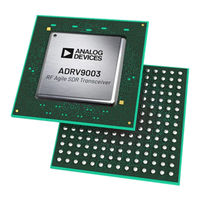Analog Devices ADRV9001 Manuals
Manuals and User Guides for Analog Devices ADRV9001. We have 4 Analog Devices ADRV9001 manuals available for free PDF download: Reference Manual, User Manual
Analog Devices ADRV9001 Reference Manual (377 pages)
Brand: Analog Devices
|
Category: Motherboard
|
Size: 30 MB
Table of Contents
-
-
-
RF Synthesizer110
-
-
External lo112
-
PLL Phase Noise112
-
API Operation114
-
-
Diversity Mode136
-
-
-
Background230
-
-
-
GPIO Operation259
-
Interrupt263
-
-
-
-
Measurement Data279
-
Network280
-
Measurement Data282
-
Network283
-
Measurement Data286
-
(Dev_Clk_In)286
-
-
-
(MCS) Input289
-
-
Recommendations290
Advertisement
Analog Devices ADRV9001 User Manual (351 pages)
Brand: Analog Devices
|
Category: Motherboard
|
Size: 26 MB
Table of Contents
-
-
-
-
RF Synthesizer104
-
External lo105
-
PLL Phase Noise106
-
API Operation107
-
-
Key Signals109
-
Diversity Mode126
-
-
-
-
Background209
-
-
-
GPIO Operation236
-
Interrupt240
-
-
Analog Devices ADRV9001 User Manual (338 pages)
Brand: Analog Devices
|
Category: Microcontrollers
|
Size: 18 MB
Table of Contents
-
-
-
External lo97
-
-
Key Signals102
-
Diversity Mode121
-
-
-
-
Rx Demodulator184
-
-
Background197
-
-
-
Interrupt226
-
-
Summary282
-
-
Initial Setup290
-
Hardware Kit290
-
Radio State331
-
Driver Debugger332
-
Log File333
-
Advertisement
Analog Devices ADRV9001 User Manual (253 pages)
System Development User Guide for the RF Agile Transceiver Family
Brand: Analog Devices
|
Category: Transceiver
|
Size: 7 MB
Table of Contents
-
-
-
External lo80
-
-
Datapath90
-
Bypass Mode93
-
SPI Mode93
-
GPIO Mode94
-
Iq Fm/Fsk96
-
-
Rx Gain Control120
-
Rx Demodulator149
-
-
Tx Dclk out180
-
Interrupt181
-



